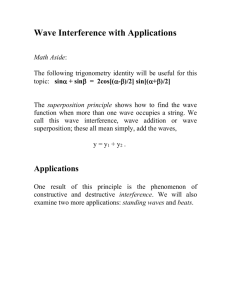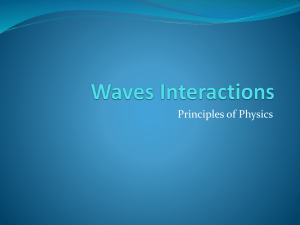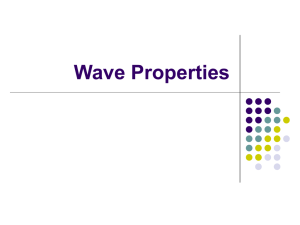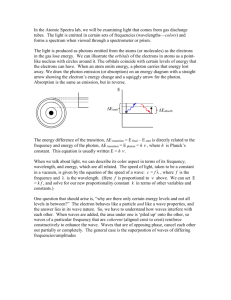Holography – Principles of Interference
advertisement
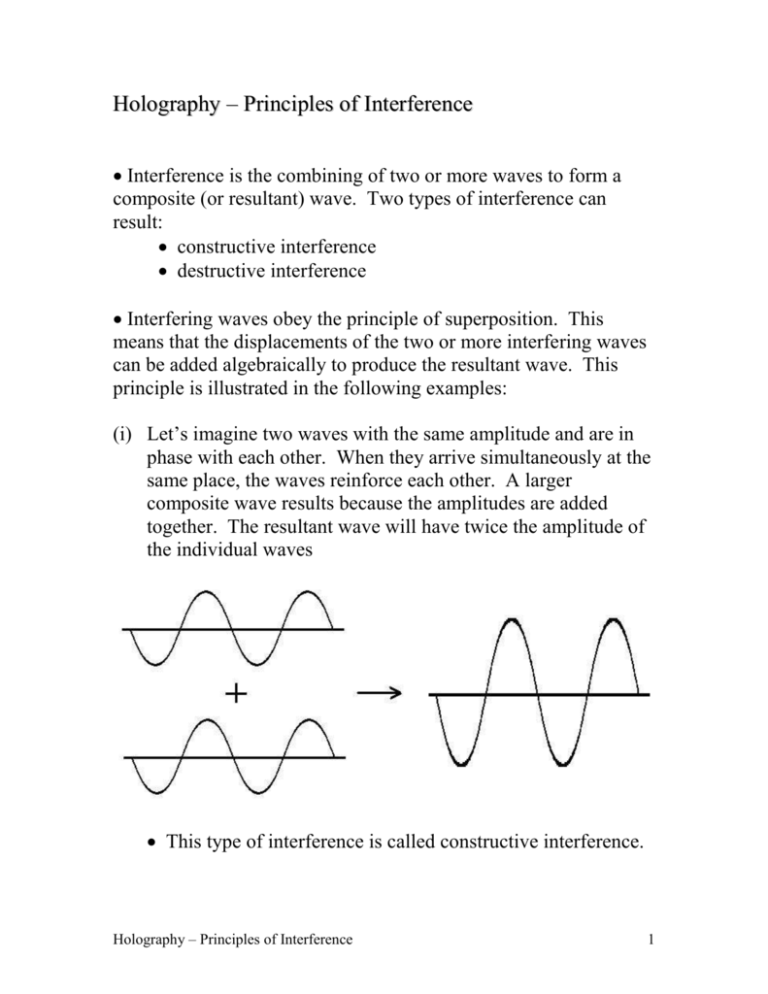
Holography – Principles of Interference Interference is the combining of two or more waves to form a composite (or resultant) wave. Two types of interference can result: constructive interference destructive interference Interfering waves obey the principle of superposition. This means that the displacements of the two or more interfering waves can be added algebraically to produce the resultant wave. This principle is illustrated in the following examples: (i) Let’s imagine two waves with the same amplitude and are in phase with each other. When they arrive simultaneously at the same place, the waves reinforce each other. A larger composite wave results because the amplitudes are added together. The resultant wave will have twice the amplitude of the individual waves This type of interference is called constructive interference. Holography – Principles of Interference 1 (ii) Now, let’s imagine the same two waves but they are exactly out of phase. When the crest of a wave arrives at a point at the same time as a trough of another wave, the waves tend to cancel each other out. As a result, no wave is produced. This type of interference is called destructive interference. ******* Let’s look at the mathematics behind this phenomenon. The equation for a traveling wave is: y = A sin (kx – t) (1) where k is the wave number and is the angular frequency. These two values are given by the following formulas: k = 2 and Holography – Principles of Interference = 2 = 2f T (2) 2 Let’s suppose two identical waves were traveling along the xaxis towards each other and produced displacements of y1 and y2 at a certain point x. We can show the displacements mathematically by rewriting (1) as shown: y1 = y0 sin (kx – t) (3) y2 = y0 sin (kx – t – ) (4) and where y0 is the amplitude and is the phase angle difference between the two waves at point x. Thus, the resultant displacement is given by adding (3) and (4): y = y1 + y2 = y0 sin (kx – t) + y0 sin (kx – t – ) (5) We can then use the relation: sin 1 + sin 2 = 2 cos ((1 – 2) / 2) sin ((1 + 2) / 2) (6) We can substitute 1 = (kx – t) and 2 = (kx – t – ) to get: y = (2y0 cos (/2)) sin (kx – t – (/2)) or y = Am sin (kx – t – (/2)) Holography – Principles of Interference (7) 3 As we can see, the resultant amplitude Am = 2y0 cos (/2) is not always constant: Let’s suppose that = 0. Then cos (/2) = cos 0 = 1. Thus, Am = 2y0. Therefore, the resultant amplitude is doubled, which is the case when the waves are in phase with each other. On the other hand, if = 180, then cos (/2) = cos 90 = 0. Thus, Am = 0. This is exactly the case when the waves are exactly out of phase. Therefore, cos (/2) = 1 cos (/2) = 0 = 0, 2, 4, 6, … = , 3, 5, 7 … constructive destructive (8) As we can infer from (8), the path difference between the two waves for constructive interference is d = 0, , 2, 3, 4, … and for destructive interference, d = /2, 3/2, 5/2, … In general, where m is an integer, the path difference between two waves can be written as: d sin = m d sin = (m + 1/2) Holography – Principles of Interference constructive destructive (9) 4 In terms of interference of light, constructive interference results in bright areas whereas destructive interference results in dark regions. The intensities of the interfering wavefronts of light combine to form a black and white pattern on the photographic plate, which will produce a three-dimensional duplication of the actual object. ******* Interference occurs anytime two waves interact, but we only get steady interference patterns when the two interacting waves are coherent. This means that the waves are in phase with each other and have the same frequency. Since frequency is inversely proportional to the wavelength (according to the formula: v = f), coherent light will also have the same wavelength. Coherent light has the same wavelength (and frequency) and thus, this corresponds to a single colour of light. Therefore, coherent light can also be referred to as being monochromatic. Lasers are highly monochromatic and thus are used in the production of holograms. The degree of coherence can be calculated using the following equation: V = (Imax – Imin) / (Imax + Imin) (10) where V is the visibility of the fringes, Imax represents the intensity at a maximum of an interference pattern and Imin is the intensity at a minimum. A value greater than 0.88 indicates a light source that is highly coherent. Holography – Principles of Interference 5 In holography, the reason why we use a beam splitter to produce two beams rather than use two different lasers is simple. It is difficult to keep two different sources exactly in phase. However, by splitting a beam into two, the beams will always be in phase and an interference pattern can be created. ******* Summary of Interference: Interference occurs when two waves of the same frequency are simultaneously present at the same place and are coherent. The two waves combine to form a single wave whose intensity depends not only on the intensities of the two individual waves, but also on the phase difference between them. In holography, the intensities of the interfering wavefronts are recorded onto a photographic plate. When illuminated properly, the three-dimensional image will appear. Holography – Principles of Interference 6

